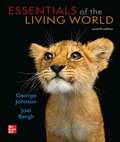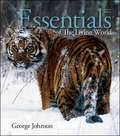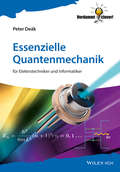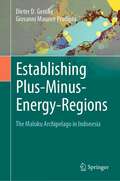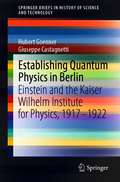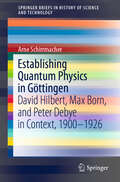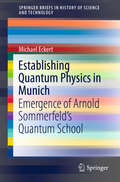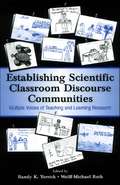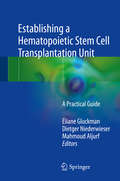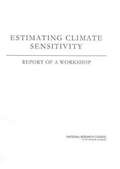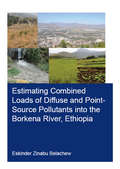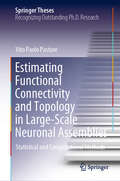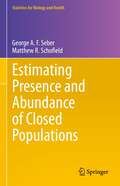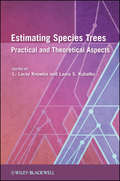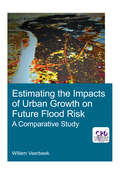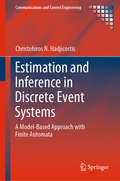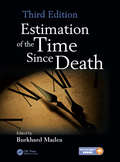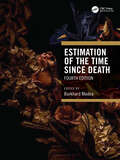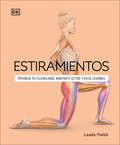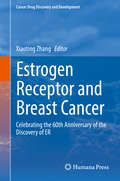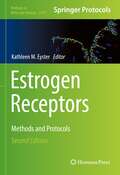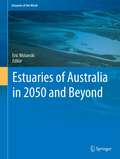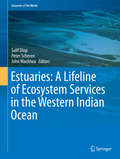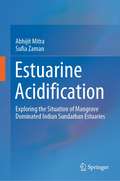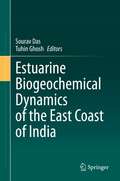- Table View
- List View
Essentials of the Living World
by George Johnson Joel BerghJohnson’s Essentials of The Living World text is written with an emphasis on the "how” and “why” of Biology, focusing on concepts rather than terminology and technical information. Utilizing a clear, straightforward writing style, the text helps students apply scientific principles to daily life. The 7th edition includes contributions and pedagogy from new coauthor, Dr. Joel Bergh.
Essentials of the Living World 4th Edition
by George B. JohnsonEssentials of The Living World is often considered a student favorite. George Johnson has written this non-majors textbook from the ground up to be an engaging and accessible learning tool with an emphasis on "how things work and why things happen the way they do". Essentials of The Living World focuses on concepts rather than terminology and technical information, and features a straightforward, clear writing style and a wide variety of media assets to enhance the content of the textbook.
Essenzielle Quantenmechanik: für Elektrotechniker und Informatiker
by Peter DeákDer Autor zeigt an Beispielen aus der Festkörperelektronik und der Quanteninformationstechnologie, welche Rolle quantenmechanische Konzepte in der modernen Energie-, Kommunikations- und Informationstechnik spielen.
Establishing Plus-Minus-Energy-Regions: The Maluku Archipelago in Indonesia
by Dieter D. Genske Giovanni Maurice PradiptaThis book explains and illustrates how Indonesia as the largest and most populous country in Southeast Asia can become independent of fossil fuels by both reducing its energy needs and using renewable resources. A study presented in this work focuses on the Maluku Archipelago in eastern Indonesia with Ambon as its capital. Conventional energy is brought to the islands over long distances by partly simple means as boats, ships and aircrafts. This unsustainable situation calls for a decentralized renewable energy supply strategy. Based on the research presented in this book, it is clear that the archipelago has the potential to become a so-called plus-minus region. Plus-minus regions are regions that produce more renewable energy than they need and capture more CO2 than they emit. The authors are convinced that the presented strategy illustrated on the Maluku Archipelago can be transferred to other regions of the world and that only by developing plus-minus regions the international 2°C climate goal can be achieved. The model region thus serves as proof that the plus-minus target can also be achieved in emerging countries with limited financial resources.
Establishing Quantum Physics in Berlin: Einstein and the Kaiser Wilhelm Institute for Physics, 1917–1922 (SpringerBriefs in History of Science and Technology)
by Hubert Goenner Giuseppe CastagnettiThis book explores Albert Einstein’s move to Berlin and the establishment of the Kaiser Wilhelm Institute for Physics under his directorship. Einstein’s call to Berlin was supported by a group of prominent physicists, including Fritz Haber, Walter Nernst, Max Planck, Heinrich Rubens, Emil Warburg, and the young astronomer Erwin Freundlich, in the expectation that Einstein and the institute would take the lead in advancing quantum physics in its early phase. Examining both the abortive attempt and the successful opening of the institute in 1917, it also discusses in detail the institute’s activities up to 1922, when Einstein relinquished the directorship, as well as his reasons for stepping down. The final chapter evaluates the institute’s activities and its role in the advancement of physics. In the end, the institute only partially fulfilled the expectations of its promoters because of the waning interest in quantum physics on the part of its director and board, and also because of Einstein’s refusal to exert scientific leadership. The book is part of a series of publications in the SpringerBriefs series on the early network of quantum physics.
Establishing Quantum Physics in Göttingen: David Hilbert, Max Born, and Peter Debye in Context, 1900-1926 (SpringerBriefs in History of Science and Technology)
by Arne SchirrmacherQuantum mechanics – the grandiose theory that describes nature down to the submicroscopic level – was first formulated in Göttingen in 1925. How did this come about and why is it that Göttingen became the pre-eminent location for a revolution in physics? This book is the first to investigate the wide range of factors that were pivotal for quantum physics to be established in Göttingen. These include the process of generational change of physics professors, the hopes of mathematicians seeking new fields of research, and a new understanding of the interplay of experiment, theory and philosophy.
Establishing Quantum Physics in Munich: Emergence of Arnold Sommerfeld’s Quantum School (SpringerBriefs in History of Science and Technology)
by Michael EckertThis book traces the history of Arnold Sommerfeld’s famous “nursery of theoretical physics” at the University of Munich and demonstrates the centrality of developing personal and institutional networks for the emergence of quantum theory. Sommerfeld, originally a mathematician with little interest in theoretical physics, was a somewhat unlikely choice for a chair of theoretical physics when he was appointed in 1906. However, he quickly reoriented his research focus towards physics, forstering a keen interest in experimental research. Possibly even more important for the development of quantum theory in the coming years was his exceptional talent as a charismatic teacher and prolific networker, which turned Munich into a central node in the fast-growing network of quantum physicists in the 1920s. It is no coincidence that the two most talented “child prodigies” of 1920s quantum physics, Wolfgang Pauli and Werner Heisenberg, were his students, nor that by the end of the decade about a dozen of Sommerfeld’s former disciples held chairs in theoretical physics. The book is directed at historians of science and physics, as well as all those interested in the history of science diplomacy and networking.
Establishing Scientific Classroom Discourse Communities: Multiple Voices of Teaching and Learning Research
by Wolff-Michael Roth Randy YerrickEstablishing Scientific Classroom Discourse Communities: Multiple Voices of Teaching and Learning Research is designed to encourage discussion of issues surrounding the reform of classroom science discourse among teachers, teacher educators, and researchers. The contributors--some of the top educational researchers, linguists, and science educators in the world--represent a variety of perspectives pertaining to teaching, assessment, research, learning, and reform. As a whole the book explores the variety, complexity, and interconnectivity of issues associated with changing classroom learning communities and transforming science classroom discourse to be more representative of the discourse of scientific communities. The intent is to expand debate among educators regarding what constitutes exemplary scientific speaking, thinking, and acting. This book is unparalleled in discussing current reform issues from sociolinguistic and sociocultural perspectives. The need for a revised perspective on enduring science teaching and learning issues is established and a theoretical framework and methodology for interpreting the critique of classroom and science discourses is presented. To model and scaffold this ongoing debate, each chapter is followed by a "metalogue" in which the chapter authors and volume editors critique the issues traversed in the chapter by opening up the neatly argued issues. These "metalogues" challenge, extend, and deepen the arguments made. Central questions addressed include: *Why is a sociolinguistic interpretation essential in examining science education reform? *What are key similarities and differences between classroom and scientific communities? *How can the utility of common knowledge and existing classroom discourse be balanced toward alternative outcomes? *What curricular issues are associated with transforming classroom talk? *What other perspectives can assist in creating multiple access to science through redefining classroom discourse? Whether this volume improves readers' science teaching, assists their research, or helps them to better prepare tomorrow's science teachers, the goal is to engage them in considering the challenges faced by educators as they navigate the seas of reform and strive to improve science education for all.
Establishing a Hematopoietic Stem Cell Transplantation Unit
by Éliane Gluckman Dietger Niederwieser Mahmoud AljurfThis text aims to provide simplified practical guidelines to start a hematopoietic stem cell transplantation unit which could be implemented in most centers and countries worldwide. The book also provides guidelines for existing transplantation units to upgrade their practice and implement new policies and procedures, in addition to developing therapies according to latest international standards and regulations. The book covers a wide range of practical implementation tools including HSCT program team structure, building inpatient and outpatient HSCT units, requisite laboratory support for transplantation program, practical aspects of stem cell collection and processing, HSCT program quality management, education and training, and data management. The book also addresses cost effectiveness and recommendations for establishing transplantation program in countries with limited resources. Written by group of internationally established experts in their corresponding hematopoietic stem cell transplantation fields, with contributions from many leaders of hematopoietic stem cell transplantation organizations, Establishing a Hematopoietic Stem Cell Transplantation Unit: A Practical Guide is an essential, practical resource for all members of the multidisciplinary hematopoietic stem cell transplantation team.
Estimating Climate Sensitivity: Report Of A Workshop
by Board on Atmospheric Sciences Climate“Climate sensitivity” is a term used to characterize the response of the climate system to an imposed forcing, and is most commonly used to mean the equilibrium global mean surface temperature change that occurs in response to a doubling of atmospheric carbon dioxide concentration. The purpose of this workshop was to explore current capabilities and limitations in quantifying climate sensitivity and consider whether there are alternative approaches for characterizing climate response that might better suit the information needs of policy makers.
Estimating Combined Loads of Diffuse and Point-Source Pollutants Into the Borkena River, Ethiopia (IHE Delft PhD Thesis Series)
by Eskinder Zinabu BelachewThis book is an initial attempt to estimate the loads of heavy metal and nutrient loads into an industrial effluent receiving rivers of a typical industrializing catchment. It shows the effects and impacts of diffuse and point sources of these loads into the rivers, and illuminate management, capacity and policy gaps of riverine water and sediment monitoring in the sub-Saharan countries perspective from Ethiopia. The study was done in semi-arid catchments of Kombolcha city with industrialising urban and peri-urban areas in north-central Ethiopia. The Leyole and Worka rivers, which receives industrial effluent and wash-off from the catchments’ areas, were monitored for two years. This book contribute to our understanding on applicable methods to quantify loads of diffuse and point sources in data poor areas, and the most important contribution is to address the gaps in in controlling emission changes and. The results of this book contribute to the theory of river protection and understanding of water quality management of sub-Saharan African tropical rivers and sediments and provides policy options for improvement in rivers water quality of the sub-Saharan countries. In bridging this gap, this book proposed a model to estimate the total loads of nitrogen and phosphorus from a catchment.
Estimating Functional Connectivity and Topology in Large-Scale Neuronal Assemblies: Statistical and Computational Methods (Springer Theses)
by Vito Paolo PastoreThis book describes a set of novel statistical algorithms designed to infer functional connectivity of large-scale neural assemblies. The algorithms are developed with the aim of maximizing computational accuracy and efficiency, while faithfully reconstructing both the inhibitory and excitatory functional links. The book reports on statistical methods to compute the most significant functional connectivity graph, and shows how to use graph theory to extract the topological features of the computed network. A particular feature is that the methods used and extended at the purpose of this work are reported in a fairly completed, yet concise manner, together with the necessary mathematical fundamentals and explanations to understand their application. Furthermore, all these methods have been embedded in the user-friendly open source software named SpiCoDyn, which is also introduced here. All in all, this book provides researchers and graduate students in bioengineering, neurophysiology and computer science, with a set of simplified and reduced models for studying functional connectivity in in silico biological neuronal networks, thus overcoming the complexity of brain circuits.
Estimating Presence and Abundance of Closed Populations (Statistics for Biology and Health)
by Matthew R. Schofield George A. SeberThis comprehensive book covers a wide variety of methods for estimating the sizes and related parameters of closed populations. With the effect of climate change, and human territory invasion, we have seen huge species losses and a major biodiversity decline. Populations include plants, trees, various land and sea animals, and some human populations. With such a diversity of populations, an extensive variety of different methods are described with the collection of different types of data. For example, we have count data from plot sampling, which can also allow for incomplete detection. There is a large chapter on occupancy methods where a major interest is determining whether a particular species is present or not. Citizen and opportunistic survey data can also be incorporated. A related topic is species methods, where species richness and species' interactions are of interest. A variety of distance methods are discussed. One can use distances from points and lines, as well as nearest neighbor distances. The applications are extensive, and include marine, acoustic, and aerial surveys, using multiple observers or detection devices. Line intercept measurements have a role to play such as, for example, estimating parameters relating to plant coverage. An increasingly important class of removal methods considers successive “removals" from a population, with physical removal or "removal" by capture-recapture of marked individuals. With the change-in-ratio method, removals are taken from two or more classes, e.g., males and females. Effort data used for removals can also be used. A very important method for estimating abundance is the use of capture-recapture data collected discretely or continuously and can be analysed using both frequency and Bayesian methods. Computational aspects of fitting Bayesian models are described. A related topic of growing interest is the use of spatial and camera methods. With the plethora of models there has been a corresponding development of various computational methods and packages, which are often mentioned throughout. Covariate data is being used more frequently, which can reduce the number of unknown parameters by using logistic and loglinear models. An important computational aspect is that of model selection methods. The book provides a useful list of over 1400 references.
Estimating Species Trees
by Laura S. Kubatko L. Lacey KnowlesRecent computational and modeling advances have produced methods for estimating species trees directly, avoiding the problems and limitations of the traditional phylogenetic paradigm where an estimated gene tree is equated with the history of species divergence. The overarching goal of the volume is to increase the visibility and use of these new methods by the entire phylogenetic community by specifically addressing several challenges: (i) firm understanding of the theoretical underpinnings of the methodology, (ii) empirical examples demonstrating the utility of the methodology as well as its limitations, and (iii) attention to technical aspects involved in the actual software implementation of the methodology. As such, this volume will not only be poised to become the quintessential guide to training the next generation of researchers, but it will also be instrumental in ushering in a new phylogenetic paradigm for the 21st century.
Estimating the Impacts of Urban Growth on Future Flood Risk: A Comparative Study (IHE Delft PhD Thesis Series)
by Willem VeerbeekThe unprecedented growth of cities has a significant impact on future flood risk that might exceed the impacts of climate change in many metropolitan areas across the world. Although the effects of urbanisation on flood risk are well understood, assessments that include spatially explicit future growth projections are limited. This comparative study provides insight in the long term development of future riverine and pluvial flood risk for 18 fast growing megacities. The outcomes provide not only a baseline absent in current practise, but also a strategic outlook that might better establish the role of urban planning in limiting future flood risk.
Estimation and Inference in Discrete Event Systems: A Model-Based Approach with Finite Automata (Communications and Control Engineering)
by Christoforos N. HadjicostisEstimation and Inference in Discrete Event Systems chooses a popular model for emerging automation systems—finite automata under partial observation—and focuses on a comprehensive study of the key problems of state estimation and event inference. The text includes treatment of current, delayed, and initial state estimation. Related applications for assessing and enforcing resiliency—fault detection and diagnosis—and security—privacy and opacity—properties are discussed, enabling the reader to apply these techniques in a variety of emerging applications, among them automated manufacturing processes, intelligent vehicle/highway systems, and autonomous vehicles. The book provides a systematic development of recursive algorithms for state estimation and event inference. The author also deals with the verification of pertinent properties such as:the ability to determine the exact state of a system, “detectability”;the ability to ensure that certain classes of faults can be detected/identified, “diagnosability”; andthe ability to ensure that certain internal state variables of the system remain “hidden” from the outside world regardless of the type of activity that is taking place, “opacity”. This book allows students, researchers and practicing engineers alike to grasp basic aspects of state estimation in discrete event systems, aspects like distributivity and probabilistic inference, quickly and without having to master the entire breadth of models that are available in the literature.
Estimation of the Time Since Death
by Burkhard MadeaEstimation of the Time Since Death remains the foremost authoritative book on scientifically calculating the estimated time of death postmortem. Building on the success of previous editions which covered the early postmortem period, this new edition also covers the later postmortem period including putrefactive changes, entomology, and postmortem r
Estimation of the Time Since Death
by Burkhard MadeaEstimation of the Time Since Death remains the foremost authoritative book on scientifically calculating the estimated time of death postmortem. Building on the success of previous editions which covered both the early and later postmortem periods this edition includes a new chapter on DNA/RNA degradation and further new content on drug testing in hair, thus widening the scope of the material. Chapters have been improved, updated and expanded, and include new and additional images to enhance the text. A unique work of synthesis combining rigorous science with practical guidance, this update reinforces the book’s reputation as an invaluable resource – and also the standard – for the estimation of the time since death.
Estiramientos (DK Science of)
by Dr. Leada MalekRelaja tu cuerpo reduciendo la tensión en los músculos y elimina la rigidez en las articulaciones con más de 100 estiramientos.El teletrabajo y el sobreuso de pantallas se ha convertido poco a poco en la nueva normalidad y corremos el riesgo de ser cada vez más sedentarios y perder la funcionalidad muscular. ¿Buscas una solución fácil y eficiente para evitarlo? Con esta guía de estiramientos podrás llevar a cabo una serie de ejercicios variados que te ayudarán a recuperar la movilidad y cuidar tu salud física.Pasa sus páginas y descubre:Más de 100 ejercicios para estirar tus músculos, acompañados de imágenes en 3D, variaciones adaptadas a tus necesidades y toda la información que necesitas para evitar lesiones y evaluar tu progreso.Instrucciones sobre cómo realizar cada ejercicio: cuál es la postura corporal correcta, qué músculos estás trabajando y cómo afectan a los movimientosEntrenamientos adaptados a diferentes habilidades y objetivos, diseñados para que progreses cada semana o cada mes.Basado en las últimas investigaciones sobre los beneficios de los tipos de estiramiento estático, dinámico y FNP (Facilitación Neuromuscular Propioceptiva) y con información sobre cómo integrarlos en tu rutina diaria.Deja atrás las malas prácticas y aprende a estirar tus músculos de manera correcta con Estiramientos, un libro repleto de sesiones de ejercicios, consejos sobre cómo realizarlos de forma segura y calentamientos para mejorar tu rendimiento y lograr tus objetivos con éxito.-------------------------------Loosen tight muscles and stiff joints with over 100 stretches designed to keep you flexible, energized, and pain-free.As working from home becomes the new normal, we risk seizing up, losing muscle functionality, and developing aches and pains from increased sedentary living. Yet, with a regular program of varied stretch workouts, everyone can reach and maintain maximum mobility.Dive straight in to discover:Specially commissioned CGI artworks depict 100 stretch exercises and variations that add or reduce challenge.Artworks detail the mechanics of each exercise, correct body posture, the muscles involved, and how they engage to perform movementsStretch workouts tailored to different abilities and aims provide suggested practices with a progressive increase in challenge over weeks and monthsThe book begins by examining the latest research on the benefits of static, dynamic, and PNF (proprioceptive neuromuscular facilitation) stretching modes. It explains how best to integrate them into your day – and use them safely in a sporting context, alongside warm-ups and exercise sessions, to enhance performance.
Estrogen Receptor and Breast Cancer: Celebrating the 60th Anniversary of the Discovery of ER (Cancer Drug Discovery and Development)
by Xiaoting ZhangThe discovery of ER by Dr. Elwood Jensen exactly 60 years ago has not only led to the birth of a whole new vital nuclear receptor research field but also made a rapid, direct and lasting impact on the treatment and prevention of breast cancer. Since that landmark discovery, tremendous progress has been made in our understanding of the molecular functions of ER and development of targeted therapies against ER pathways for breast cancer treatment. However, there is currently no book available addressing these discoveries and recent advancement in a historical and systematic fashion. This book is intended to provide comprehensive, most up-to-date information on the history and recent advancement of ER and breast cancer by world renowned leaders in the field. These chapters include the history of the discovery of ER; physiological and pathological roles of ER; recent discovery of ER cistrome, transcriptome and its regulation of noncoding RNAs such as microRNAs and enhancer RNAs in breast cancer; development and clinical practices of the first targeted therapy Tamoxifen and other antiestrogens for breast cancer treatment; structural basis of ER and antiestrogen actions; molecular insights into endocrine resistance; the role of ER mutants, ER-beta and environmental estrogens in breast cancer; and emerging state-of-the-art therapeutic approaches currently in development to overcome treatment resistance and future perspectives. The book will provide undergraduate and graduate students, basic scientists and clinical cancer researchers, residents, fellows, as well as clinicians, oncology educators and the general public a thorough and authoritative review of these exciting topics.
Estrogen Receptors: Methods and Protocols (Methods in Molecular Biology #2418)
by Kathleen M. EysterThis fully updated collection includes chapters on a wide array of techniques that are vital for advancing our understanding of the physiological and pathological effects of estrogen, mediated by estrogen receptor α (ERα) and estrogen receptor β (ERβ) as well as the non-genomic membrane-bound G-protein coupled estrogen receptor (GPER/GPR30). The protocols range from standard methods and important laboratory workhorses such as immunoblot and RT-qPCR, to newer technologies such as PET imaging, reporter animal models, polysome fractionation, and many others, involving a broad range of tissue types to demonstrate the variety of estrogen receptor effects. Written for this highly successful Methods in Molecular Biology series, chapters include introductions to their respective topics, lists of the necessary materials and reagents, step-by-step, readily reproducible laboratory protocols, and tips on troubleshooting and avoiding known pitfalls. Authoritative and practical, Estrogen Receptors: Methods and Protocols, Second Edition serves as an ideal guide to researchers working to explore the vibrancy and excitement of the field of estrogen receptors and estrogen actions.
Estuaries of Australia in 2050 and beyond
by Eric WolanskiThe book addresses the questions: Is Australia's rapidly growing human population and economy environmentally sustainable for its estuaries and coasts? What is needed to enable sustainable development? To answer these questions, this book reports detailed studies of 20 iconic Australian estuaries and bays by leading Australian estuarine scientists. That knowledge is synthesised in time and space across Australia to suggest what Australian estuaries will look like in 2050 and beyond based on socio-economic decisions that are made now, and changes that are needed to ensure sustainability. The book also has a Prologue by Mr Malcolm Fraser, former Prime Minister of Australia, which bridges environmental science, population policy and sustainability.
Estuaries: A Lifeline of Ecosystem Services in the Western Indian Ocean
by Salif Diop Peter Scheren John MachiwaThis book provides recent environmental, ecological and hydrodynamic information for the major estuaries and the coastal marine systems of the Western Indian Ocean Region. It covers various functions and values of the region's estuarine ecosystems and their respective habitats, including the land/ocean interactions that define and impact ecosystem services. The Western Indian Ocean region covered by this volume consists of the continental coastal states of Kenya, Mozambique, South Africa and Tanzania and the island states of Madagascar, Mauritius, Seychelles and Comoros.
Estuarine Acidification: Exploring the Situation of Mangrove Dominated Indian Sundarban Estuaries
by Abhijit Mitra Sufia ZamanThis book provides a cross-sectoral, multi-disciplinary assessment of different problems associated with estuarine acidification with special thrust on mangrove dominated Indian Sundarban estuaries. The arms of ocean acidification have extended to coastal and estuarine waters, where a wide spectrum of biodiversity thrives with unique adaptation extending several ecosystem services. Impact of acidification in these areas is a matter of concern as acidification potentially has more immediate effects on the health of estuaries and inshore regions as well as regional economies. Ground zero data collected for more than three decades have made the book stand on a strong base.
Estuarine Biogeochemical Dynamics of the East Coast of India
by Tuhin Ghosh Sourav DasThis book provides a comprehensive overview of recent research on estuaries of the east coast of India, and how changing biogeochemical dynamics as a result of climate change and human activity have impacted estuaries and other open water ecosystems. Though estuaries only cover a very small portion of the earth’s hydrosphere, they are some of the most biogeochemically active regions among the global water bodies. As such, this book focuses on estuaries of the east coast of India going all the way to the Bay of Bengal, which is the world's largest freshwater input from perennial rivers and rain-fed estuaries, and is therefore a unique area of study. Through its unique coverage of the Bay of Bengal in particular, the book presents a new perspective not present in the literature on estuary biogeochemistry and ecosystem dynamics. Moreover, the book addresses SDG 13 (Climate Action) and 14 (Life below Water), with a focus on ecosystem services of the natural aquatic system.The book will be useful to researchers, policy makers, coastal managers and marine sustainability scientists and organizations.
